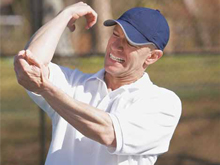Health Topics
-
Healthy Living
-
|
|
January 2011
|
Being Tendulkar
Non-Surgical Management of Tennis Elbow |
| Dr P Sharat Kumar |
| |
 |
When Sachin Tendulkar recently hit his 50th century, some did remember the time when his career was under a dark cloud, due to a painful tennis elbow. Here’s reflecting on the medical condition - an ode to the Little Master. |
Tennis elbow is a painful condition of the outer elbow which affects almost one to three percent of the people. The pain may develop suddenly or gradually and is intensified by grasping and twisting movements of the hand. This condition, once developed, can last for a few weeks to a few years.
Not Just Tennis
Tennis elbow is considered to be a result of overuse and excessive mechanical stress of the forearm extensor muscles – like Tendulkar. Occupation and sports activities which require repetitive and forceful motion of the forearm and the wrist can lead to this condition. Sports which involve the use of the upper extremities such as tennis, non dominant leading arm in golfers and gymnasts, pose a high risk for their players to develop tennis elbows.
People in the age group of 30 to 60 years are most at risk. Although it is called tennis elbow, it can occur in any and can affect both men and women equally.
Non-surgical or conservative management has met with proven success rates (82 to 93 percent) in treating cases of tennis elbow.
8 Non-Surgical Methods
- Rest is of utmost importance, and avoidance of activities which aggravate the pain is recommended. A cast or splint is sometimes given to relax the forearm muscles. Gentle exercises should be done daily to avoid stiffness.
- Cryotherapy or ice application helps in acute cases. Ice packs can be applied four to eight times for 15 to 20 minutes every day. Care should be taken to not to apply ice directly in order to avoid frostbite.
- Therapeutic ultrasound is another such technique, though not much research has gone into this to prove its effectiveness. It is most commonly used at a frequency of 3.0 or 1.5 MHz in either pulsed or continuous mode.
- Low-dose extracorporeal shockwave therapy has been sometimes seen to relieve chronic elbow pain permanently. A moderate to intense sensory input is applied at the point of most discomfort for a few seconds to 30 minutes, and pain is alleviated.
- Counterforce bracing is done with the help of a 5 cm, non-elastic, fabric band lined with rubber foam padding. The maximum contraction of wrist and finger extensors is inhibited by this band but it is recommended to be used for support only during strenuous physical activity. Care should be taken to avoid excessive tightness.
- Manipulation is done sometimes with the aim to turn a partial tear of the conjoint tendon into a complete one to detach the tendon from the persistently inflamed periosteum (dense fibrous membrane covering the surface of bones and serving as an attachment for tendons and muscles). A procedure called the Mills manoeuvre is performed with the wrist in full flexion, with the palm directed downwards, and the elbow is suddenly moved from a flexed position to full extension. After that, the site is injected with 1ml of two percent lidocaine.
- Corticosteroid injections alone or in combination with local anaesthetic agent are given over the tenderest spot. A common side effect of this treatment is worsening of pain immediately after the injections for one hour to four days. Repeated injections can also lead to tendon degeneration. Also, their effectiveness has not been well established.
- Autologous blood injections are platelet derived. They help in faster growth and are thought to stimulate a healing response.
Although non surgical methods are preferred over surgical ones for tennis elbow, the condition can often reoccur. The best preventive in all the cases is strengthening and stretching exercises. Care should be taken to maintain correct techniques of playing and lifting heavy objects. Undue force and pressure should be avoided on the elbow and forearm muscles. |
 |
Dr. P. Sharat Kumar is Orthopaedic and Sports Medicine Consultant at
Apollo Health City, Hyderabad |
|
|